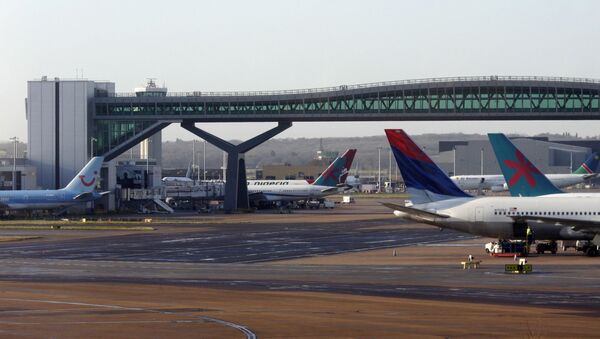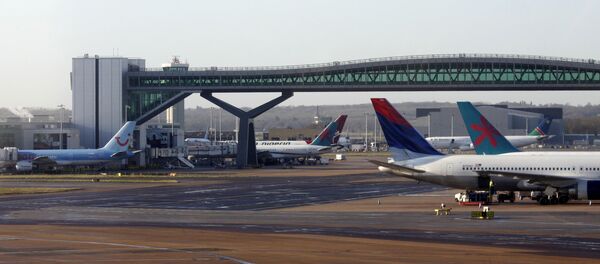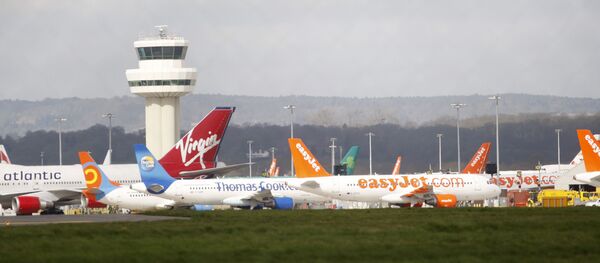Sputnik: How can police prevent drones from entering airports' airspace? How can they be disabled or downed?
Professor Kevin Curran: Aside from geo-zoning of drones by manufacturers that prevent them flying into designated restricted areas such as airport airspace, there are a number of military-level drone defence systems available such as the Drone Dome counter-unmanned aircraft system (C-UAS) or Citadel Defense Titan system. Titan, for instance, uses sophisticated wireless signal jamming which attempts to disrupt drone wireless transmission frequencies. There is also the DroneTracker system from Dedrone for detecting drones and Battelle DroneDefender which can also bring a drone back to earth in a controlled fashion. Drone Dome also contains radar detection and wireless signal jamming capabilities.
Professor Kevin Curran: The government could try to enforce a mandatory drone registration remote identification (ID). In the USA for instance, they have a drone digital flight authorization system for operational intent in restricted airspace. This is known as Low Altitude Authorization and Notification Capability (LAANC).
India has rolled out a Digital Sky regulation which includes drone registration in addition to other moves such as enforcing airspace authorization and geofencing. It is known as a "No Permission, No Take-off (NPNT)" regulation. There is a proposed UK government policy for a mandated Drone Flight Information and Notification System (FINS).
The most effective measure, however, is to have geo-tagged drones which adhere to internal flight restriction. The leading commercial drone manufacturer DJI Technology embeds this in their AeroScope product which gives location and serial number information to police and aviation safety officials. That seems to be the most pragmatic approach to take for tracking drones at this time. A national drone flight authority could easily set the restricted airspace locations used for enforcing these flight restrictions.
Sputnik: Could drones violating airports' airspace be shot down with missiles?
Professor Kevin Curran: Shooting down drones is a hard task. Yes, there are some drone laser defence systems that try to minimise collateral damage but this is hard as most airports are in urban areas. Apart from military bases and wartime, it is difficult to see any modern airports launching missiles to bring down drones but this is an active area of research. Hawks and other more traditional techniques have been trialled in prisons to attack drones.
Professor Kevin Curran: Yes, airports have now become aware that they have to invest more in technology that detects and ultimately prevents drones from flying in its airspace.
The wider treat, of course, is that terrorist use drones for attacks in general. For instance, drones can be used by terrorists both to assassinate high profile public leaders or to bring down aircraft. They are a major worry for the future and I suspect we will see drone assassination or drone suicide attacks dominate the news in the future. There are many scenarios where the use of drones by terrorists can lead to catastrophic events. For instance, at any major events these days such as a stadium concert, stadiums have become the 'Fort Knox' of old with layers of security so a terrorist would find it difficult to make an impact at such an event.
However, it would not be as difficult for a terrorist to drive to within a few miles of that stadium, open a truck and release a swarm of drones which fly to the stadium (using pre-programmed co-ordinates) and drop chemical weapons or some other payload. That is why we will see anti-drone protection services crop up to counteract these threats in places other than airports. Any major public venues will need anti-drone technology. In 2015, a drone carrying radioactive materials landed on the roof of the Japanese Prime Minister.
The UK's Department for Transport used the military contractor Qinetiq to carry out a series of test crashes between drones and planes, to find out exactly how much damage a quadcopter could cause in a real-life collision. In fact, there has been a 168% increase in drone and plane near-misses over the last recorded two-year period. Last year, a Virgin Atlantic B787 flying at 3,200 feet above London narrowly avoided a collision with a drone by just 20 feet in its approach to Heathrow.
Professor Kevin Curran: Authorities around the world are aware of the crimes which drones can be used for. Since December 2015, the Federal Aviation Administration (FAA) mandates that all owners of model aircraft, small unmanned aircraft or drones, or other RC aircraft weighing between 0.55 and 55 pounds need to register online before flying their drones. This is a step towards identification plates of a sort. This registration system requires drone owners to submit their name & address to receive a Certificate of Aircraft Registration/Proof of Ownership.
This will include a unique identification number owners must affix to any drone they own and operate exclusively for recreation. The fee is only $5. Anyone who purchases a drone must register before flying outdoors. Once registered, the registration will be valid for three years. Owners will also be able to cancel registration as circumstances require (e.g., aircraft destruction, transfer, sale, change in owner eligibility to register). A failure to register an aircraft can result in civil penalties up to $27,500. Criminal penalties for failure to register can include fines of up to $250,000 under 18 U.S.C. 3571 or imprisonment up to three years.
Sputnik: Current laws allow drones to operate within 1km of an airfield boundary. By how much should the radius be extended?
Of course, drone laws are being ushered in globally. For instance, last week the UK government announced it will tighten the law to tackle the illegal use of drones after flights were disrupted at Gatwick and Heathrow airports. Some proposed policies in the UK include a minimum operator age requirement, new powers to enable law enforcement to properly monitor drone usage and a mandated Drone Flight Information and Notification System (FINS). Also, the Drone (Regulation) Bill 2017-19 is seeking to regulate the purchase and use of drones weighing 5kg or more.
Technology develops faster than law and with the drone industry expanding, this is a problem. Policy makers are having a difficult time keeping up. Some countries seem to have clear established drone laws but many do not. For instance, in the US, the release of the Part 107 rule by Federal Aviation Administration (FAA) for drones below 55lb has paved the way for multiple opportunities in commercial sectors such as mapping, surveying, and inspection, among others. The FAA reports that the drone regulations could help add $82 billion to the US economy, as well as 100,000 jobs in the next 20 years.
The European Union (EU) meanwhile is working on standardising laws and coming up with a pan-European framework. At the moment, it is on country by country basis so in Switzerland, you can fly commercially if you have line of sights, with an altitude ceilings and not flying close to the protected sites like airports but in France, any flight over Paris requires authorization from aviation authorities. In 2015, the Government of Bangladesh banned all unmanned aerial vehicles, which did not have permission prior to December 2014. In Kenya, users need a permit from the defence ministry which is a lengthy process requiring rounds of paperwork and large fees.
Ultimately, the more that drone becomes intelligent the more the public will see the value of them. There is a real fear of invasion of privacy so the drone industry & authorities needs to counter that early. The future of drones is tools and not toys so that is why the commercial sector should surpass the consumer sector sales sooner than we expect. Drones will become the most dynamic growth sector within aviation soon.
Professor Kevin Curran: Countries are now rushing to enforce compulsory registration of all commercial and civilian drones due to concern over the use of drones by individuals with little knowledge of aviation rules. Typical restrictions include flying it within 150 metres of a congested area and 50 metres of a person, vessel, vehicle or structure, not under the control of the pilot. In effect, users must fly drones "within sight".
Owners must not go above 400 feet in altitude or further than 500 metres horizontally. If they wish to exceed this, they need to seek explicit permission from the Civil Aviation Authority (CAA). In 2015 UK Airprox Board (UKAB) reported that there were 23 near misses between aircraft and drones. 12 were given an A rating — meaning there was "a serious risk of collision". In one incident a drone passed within 25m of a Boeing 777 near London Heathrow Airport.
There are separate rules for commercial use. Commercial drone pilots are required to seek permission from the CAA. To get a licence they have to show they are "sufficiently competent". There was a case of an individual named Robert Knowles was fined £800 and ordered to pay costs of £3,500 after being prosecuted by the Civil Aviation Authority (CAA) for flying a drone within 50 metres of the Jubilee Bridge and flying over a nuclear installation, the BAE System submarine-testing facility.
READ MORE: UK Military Sends 'Assistance' to Heathrow Airport After Drone Sighting Chaos
Professor Kevin Curran: A case can be made for limiting drones until legislation is implemented but in practice, this is very difficult. Unless an outright ban was made on the sale of drones, then the authorities need to concentrate on educating users. Safety issues are a core risk. People are worried about drones falling from the skies, drone blades severing limbs and of course collisions with commercial aircraft. What the public fails to understand however is that modern uncrewed aerial systems can be preprogrammed to avoid no-flyover zones — both uploaded by the public and those set by airports and military. Modern drones also are beginning to ship with anti-collision systems on board and these make a big difference for future safety.
Owners should become aware of the regulations of flying commercial drones. In the UK, drones are regulated by the UK's Civil Aviation Authority (CAA) and split up into three different weight categories: < 20kg, 20kg-150kg, and 150kg+. For the lightest tier, you do not need a certificate or permit to start flying your drone. The only exception is for "aerial work," which refers to any flights where the pilot is paid. If the drone weighs 20kg or more, you will need a permit from the CAA first. However, most hobbyist consumer drones are significantly lighter than this, so even if you were attaching heavy camera gear you are unlikely to hit this higher weight bracket.
READ MORE: UK Ministers, Airport Heads to Discuss Drone Incidents on Thursday — Reports
Sputnik: Do you think stricter regulation will lead to more illegal drones?
Professor Kevin Curran: Stricter regulation could indeed lead to more illegal drones. Legislation and regulatory restrictions are not the final solution. Honest decent drone operators adhere to best practice and regulations but of course, the terrorist and rogue drone operators will simply engage in deliberate criminal acts and ignore the regulations. In fact, restrictive regulations will simply alienate all law-abiding drone users.
The views expressed in this article are those of the speaker and do not necessarily reflect those of Sputnik.









